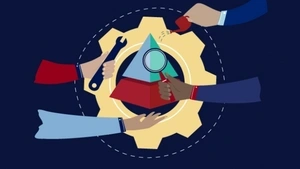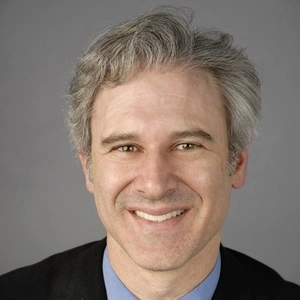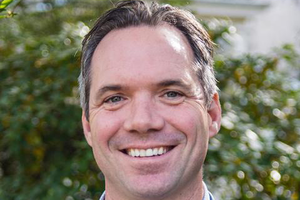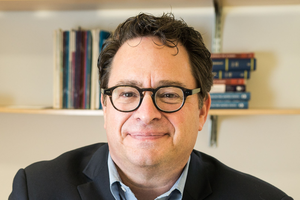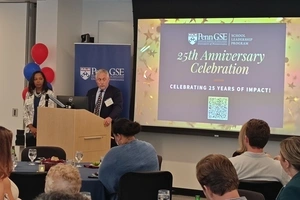Faculty Expert
-
John D’Auria
Adjunct Professor
Across the United States, schools are waiting to see how a predicted winter surge in COVID-19 cases might test an already fragile mix of in-person, online, and hybrid classes. Penn GSE’s Jonathan Supovitz and John D’Auria believe that to meet the pandemic’s challenges, schools must do what they ask students to do every day: learn.
Supovitz and D’Auria recently created Leading Improvement in Challenging Times, a guide and companion video to help leaders collaborate within their districts, schools, and teams to address questions of equity, access, technology, pedagogy, and social-emotional support.
In their work, Supovitz and D’Auria partner with experienced school leaders to tease out common points of conflict and tension in education, and provide guidance for how to move these situations forward. They introduce the Leadership for Learning Framework, which has three main components:
1. A set of essential conditions that schools must have in place to engage with these challenging times.
2. Systematic improvement processes that allow teams to identify the core problems that impede school effectiveness, and engage in a process of developing hypothesized solutions, testing those hypotheses, learning from the results, and iterating that learning into a more refined approach.
3. A set of leadership skills with which to navigate the challenges of uncertainty and guide the organization toward learning and improvement.
Here’s an example of each component, and why they matter for school leaders:
1. An Essential Condition: Psychological Safety
The foremost essential condition for high quality interactions among adults within professional settings is what Amy Edmondson calls psychological safety: the belief that one will not be punished or humiliated for speaking up with ideas, questions, concerns, or mistakes.
The degree to which educators are able to share vulnerabilities, acknowledge mistakes, respectfully disagree, and challenge the thinking of colleagues as well as those with more status and power provides insight into the perceived level of psychological safety within an organization. One of the key ways that a leader can contribute to psychological safety is by choosing to use influence more than authority to gain educator commitment. Influence is more about engagement, collaboration, and building the trust and commitment to improve rather than using one’s authority and expecting compliance to a new set of expectations.
2. An Improvement Process: Plan-Do-Study-Act
Plan-Do-Study-Act (PDSA) cycles are disciplined inquiry in action. An important benefit of the PDSA cycle as a strategy for practitioners is that it sequentially combines the entire improvement process in one framework. As the name indicates, the process has four elements:
- Plan: Just like the phrase “look before you leap,” a little planning can go a long way. Bringing in multiple perspectives can help identify the real problem you are trying to address and what you should really be trying to change. Planning occurs in two levels at the same time. First, planning involves thinking through the actual change you plan to adopt. What exactly is the change, reform, or intervention that you intend to introduce and how will you go about introducing the change? What sequence of steps will you follow? The second part of the planning process is to plan for a way to assess the impact of the planned change. This focuses on hypothesizing exactly what will be different after you introduce the change and what evidence you will use to assess the difference. During the planning process it can be helpful to identify a focusing question (or research question), which helps you to target and clarify the central emphasis of your inquiry.
- Do: The “do” part of the PDSA cycle is to actually enact the change that you have planned. This also includes collecting the data you have planned to collect and organizing it in preparation for analysis.
- Study: The “study” component of the PDSA cycle is to analyze the data you have collected and assess the impact of the planned change. Did it meet its goals? Why or why not? Should you revise the reform and iterate again? Are you ready for wider enactment?
- Act: The “act” part of the PDSA cycle is to either make an adjustment and iterate through the improvement cycle, or spread the change more widely because you feel confident in its efficacy. Even if you spread the change more widely, it can still be valuable to collect and analyze data for ongoing improvement.
3. A Leadership Skill: Listening in Stereo
Listening in stereo is the ability of a leader to listen carefully to both the content of the conversation and how it is expressed. As Peter Block notes in Flawless Consulting, we should remember that personal data are facts that matter too. “They concern how individuals feel about what is happening to them and around them. If people feel they will not get a fair shake, it is a ‘fact’ that they feel that way, and it is also a ‘fact’ that this belief will have an effect on their behavior. To ignore this kind of ‘fact’ is to throw away data that may be crucial to any problem-solving effort.”
When we discuss listening in stereo we are emphasizing that hearing and acknowledging the feelings embedded in communication are invaluable parts of data collection and trust building. Emotions are data, and overlooking the data communicated through peoples’ affects often produces blind spots that can negatively impact understanding and decision making.

The Leading Improvement in Challenging Times training series was funded by The Harold W. McGraw, Jr. Family Foundation, a not-for-profit foundation focused on supporting education, youth services, community health, and medical research.
Subscribe to the Educator's Playbook
Get the latest release of the Educator's Playbook delivered straight to your inbox.
Media Inquiries
Penn GSE Communications is here to help reporters connect with the education experts they need.
